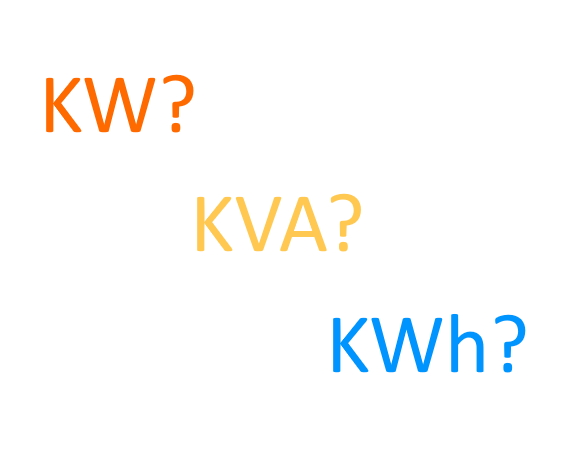“What is a KW?”
A KW is a unit of electrical power, and it means 1000 Watts.
‘K’ or Kilo is 1000, and ‘W’ or Watt is a unit of electrical work, or Power. For example, a 50 Watt or 50W lightbulb consumes 50 watts of power.
To convert Watts (W) into KiloWatts (KW), divide by 1000. So 50W = 0.05KW.
To convert KiloWatts (KW) into Watts (W) , multiply by 1000. So 1KW = 1000 Watts.
“What is a KWh?”
A KWh is a unit of stored electrical power, or power discharged over time, and it means 1000 Watts x 1 hour.
‘K’ or Kilo is 1000, and ‘W’ or Watt is a unit of electrical work, or Power. For example, a battery with a capacity of 5000 Wh, or 5KWh can discharge 5000 watts of power for 1 hour, or the equivalent, over a different time (2.5KW over 2 hours, etc).
“What is KVA?”
KVA stands for Kilo-Volt-Amps, and it means 1000 VA. (Volt-Amps)
KVA is a unit of apparent electrical power. The Active power in KW can be calculated by multiplying the power factor (usually between 0.7 and 1) by the Apparrent Power in KVA.
For example:
2.4KW = 0.8 x 3.0KVA
For an Inverter with a rating of 3.0KVA, with a power factor of 0.8, the actual output power will be 2.4KW. Power factor is a measure of reactance of a circuit, causing reduction in active power output from 1 (zero reactance) to a fraction of 1, like 0.8.
“What is a circuit?”
Usually, a household in Australia contains 5-12 electrical circuits, each feeding one type of electrical load, usually all of the same type.
For example, most houses have the following circuits, visible by their fuses in a switchboard:
- Main Line (often 63A fuse)
- Hot water (often 10A or 16A)
- Power 1 (10A – 20A)
- Power 2 (10A – 20A)
- Lights (6A – 10A)
- Air Conditioning (6A – 10A)
- Various others: Pool Pumps, Car Chargers, Solar Inverters, Batteries,
“What is an MCB?”
Coming soon…

